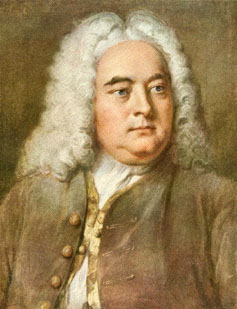Strip Handel
Strip Handel developed out of the Neo-Classical movement. Its founders, three young and innovative musicians, were becoming fatigued with playing the non-provocative clothed music of their trade. In a moment of divine inspiration they decided to take the glorious music of George Frideric Handel, specifically Messiah, back to its earthy and humanistic qualities, as opposed to perpetuating all the pomp and ceremony that has become associated with this piece. By lifting the burden of propriety from the rousing strains of Handel, both the musicians and the audience can better partake of and experience the ecstasy, fulfillment, and intense musical drive that is The Messiah.
How does it work?[edit | edit source]
At the outset of this artistic anomaly the entire orchestra and choir are clothed in the customary garments. Just as the different instruments and voices have their respective entrances and exits, so do the clothing they are wearing. Using the famed Hallelujah Chorus as an example, when the piece begins the performers are in their traditional uniforms. As the music builds to its natural climax the uniforms transform from conventional and oppressive, to expressive and freeing. The orchestra removes layers in an organized and artistic manner, a bow tie at measure 54, a necklace at measure 69. At the end of the last rousing repetition of Hallelujah all the performers are in the gloriously natural state that Handel was intended to be experienced in. The conductor remains clothed until the last chorus so as to not shorten the spiritual experience for the audience.
History[edit | edit source]
Although strip Handel was originally established by three promising musicians in America, its motherland was not nurturing of the young, new, style of performance. Luckily, for the music aficionado strip Handel was firmly embraced by Europe, most notably Paris. Strip Handel earned its prestige in the diminutive, more liberal venues of the Red Light District. Subsequently, Strip Handel swiftly made its way into mainstream London, Aberdeen, Dublin and Sidney. It was particularly appreciated in Dublin’s Temple Bar district, the home of the first performance of Handel’s Messiah. Strip Handel did eventually return to its Yankee roots, the most prominent cities being New York, San Francisco, and Seattle. Music critic Kayti King was quoted as saying after the first performance "It was clear after the first brilliant tenor solo, sung by the critically acclaimed Andrew Harris, that the high notes were never so high, nor the low notes so low. The excitement exuded by the soloist was harrowing at the deepest level. It was stunning, this piece of musical and physiological genius is certain to obtain standing ovations every time!" Another critic claims "The artists knowledge of music and the human soul carefully merge to create one beautiful release of music. The crescendo into the last Hallelujah left me breathless and wanting more."
The first performance conducted by Olivia Heckelsmiller was recorded in this section of Ben Marsh's 2006 work "Love Handel."
"That night was the very first time I had ever felt the true presence of God. As the musicians did, I threw off my earthly garments of shame and was exposed to the true presence of the Lord."
